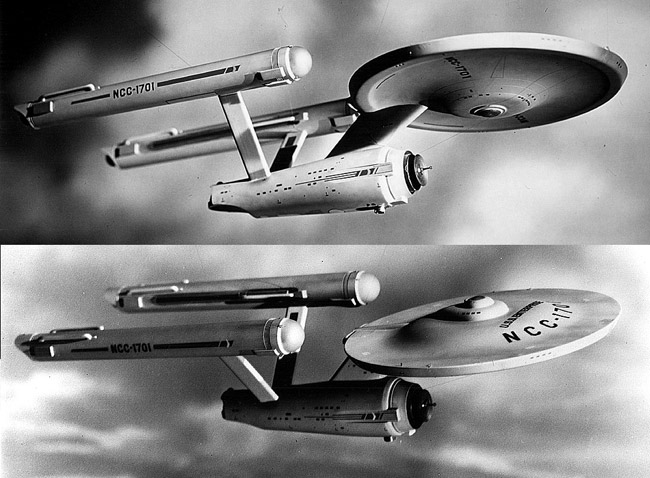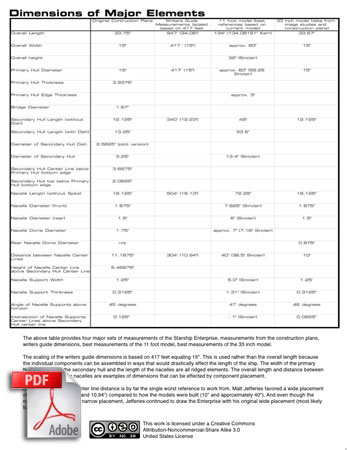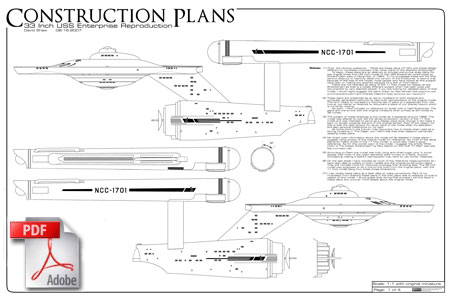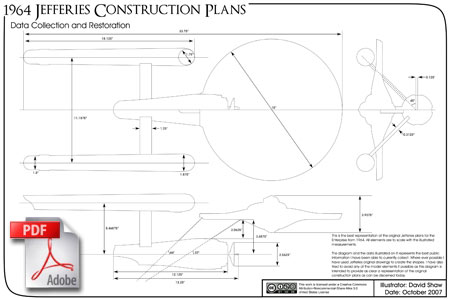History of the 33 inch model of the Starship Enterprise
by David Shaw

Introduction
First let me say "Welcome". If you are reading this, then either I've sent you the address of this page or someone I sent this address to has passed it along to you. This is not meant as a public page and a lot of the details noted below are still sketchy at best. This is more or less a snapshot of my understanding of this subject, an understanding which is evolving with each day I spend researching this topic.
While my main focus is on the lost 33 inch model of the Enterprise, the broader subject at hand is all three of the models which represented the Enterprise on screen during the three seasons of the original Star Trek series. So there is a lot of extra information presented.
Early History
- August 1964: A final overall configuration was picked, a color illustration was done and a study model was made by Matt Jefferies. The next few months would be spent working out the details of the ship. Here are some of his sketches during the intervening period and his accounting of events.
- Matt Jefferies: "By the third time around he had two sheets of eight or ten drawings, plus a half dozen good-size renderings. One of them was the beginning of the design finally chosen and one that I liked very much... an upper, saucer-shaped hull, a cigar-shaped lower hull, and two engine pods. Before calling everyone in again, I did a little fast model building. I went down to the mill [woodworking shop], grabbed a couple of chunks of wood, and had the men turn out the saucer shape on a lathe. In about thirty-five to forty minutes I had a model. We hung it up on a piece of thread and called everyone in. Oddly enough, the original model was hung upside down as opposed to the way we use it now."
"Based on that model and the color renderings I had prepared for it, Roddenberry felt we were on the right track. We wound up shortening the main pylon strut and made a few other little changes and then sat down to to some scale drawings."
- Nov. 4, 1964 (Wednesday): Richard Datin agrees to build an approximate three foot long model based on an early set of plans which give a real world scale of 1:192 (if this had been the final drawings, this would have been the 540' version, but the proportions of this early drawing are actually different from the final plans) for the final large scale model (the plans on the page would have most likely been 1:48).
- Nov. 7, 1964 (Saturday): The final construction plans are finished. These plans include the scale reference of FULL SIZE & 3" = 1'-0" TO LARGE MINIATURE. As the one feature linking the scale of the model to the live action sets is the bridge, the overall size seems to have already been determined by this point. In fact because Jefferies didn't want windows or the like on the surface of the ship, the bridge was the primary feature that would be used to sell the size of the ship in the pilot.
- Nov. 8, 1964 (Sunday): Datin receives the plans and starts building the full size 33 inch model out of kiln-dried sugar pine. This date needs to be double checked with Datin. The drawings are labeled November 7th and I'm assuming he got the drawings within 24 hours of their completion.
- Nov. 15, 1964 (Sunday): A little more than a week later the 33 inch model is presented to Roddenberry for approval. I'd guess this is where the request for the addition of exterior windows takes place (which were not part of the original design). The windows seen on the few elements of the original drawings were added after the original completion date of them. My understanding is that Roddenberry was constantly asking for more details.
- Nov. 27, 1964: Live action shooting is scheduled for the Transporter Room, Enterprise Passageway and Pike's Quarters.
- Nov. 30, 1964: Live action shooting is scheduled for the Bridge (which means construction of it might have been started by around the 15th). This day's schedule includes the crane shot of the bridge that will eventually be composited with the (as yet) unstarted 11 foot model.
- Dec. 1, 1964: Live action shooting is scheduled for the Bridge and Orion Courtyard.
- Dec. 8, 1964 (Tuesday): Construction is started on the 11 foot model.
- Dec. 14, 1964 (Monday): The 33 inch model is delivered to Roddenberry while The Cage was being filmed in Culver City (40Acres). This model is used for all effects shot in The Cage except the most important one (the zoom in on the bridge). Images of the model being delivered seem to be on the Rigel Fortress set, but filming was originally scheduled for December 8th for those shoots. Either this date should actually be the 8th or the shooting schedule met with delays. December of 1964 was rainier than normal for most parts of California, so the Rigel Fortress shoots might have been delayed.
- Dec. 24, 1964 (Thursday): Shooting of The Cage wraps, only one effects shot still outstanding.
- Dec. 29, 1964 (Tuesday): The 11 foot model (built by Datin, Mel Keys and Vern Sion) was delivered to the Howard A. Anderson studio. This version is unpowered and the windows are painted on the surface of the model... and even then the model was designed to be shot from the right side only.
- Jan. 23, 1965 (Saturday): After The Cage is already in the can and waiting for network approval of the new series, additional test shots of the 11 foot model are taken in it's original configuration.
- Jan. 30, 1965 (Saturday): Aspects of the ship's size (like it being 190,000 tons) were being distributed to the media in the descriptions of the new show.
- August-September 1965: The 11 foot model is modified to include inner lighting and more surface detail. It doesn't appear that the 33 inch model was modified at this time, but the only noticeable detail that would have been different between them was the rear of the nacelles, and the only shot of the 33 inch model in Where No Man Has Gone Before was of it exiting the energy barrier.
- April 1966: The 11 foot model is further altered for the now approved new series. Some of the previous changes needed to be unmade... the bridge had two large windows cut into it and to remove them the bridge was cut in two along the top edge of one of the windows. The top half was returned to the model and the bottom half discarded. The 33 inch model was also modified around this time to match the 11 foot model.
Appearances
The 33 inch model was seen on screen in a number of episodes... strangely far more than is generally known by most fans. Here is a list of episodes where the model was seen (not counting it's appearance in the opening titles of every episode)...
The Cage
Where No Man Has Gone Before
Tomorrow Is Yesterday
By Any Other Name
Is There in Truth No Beauty?
Requiem for Methuselah
For comparison, the 18 inch AMT model of the Enterprise was used in only The Doomsday Machine and The Trouble With Tribbles.
Physical Characteristics
A few years ago someone asked if there were any plans of the 33 inch model available (there are a number of fan produced plans for the 11 foot model that do a rather nice job of documenting it's details). The response was "no and there never will be as the model was lost years ago". That response made me take a closer look at the possibilities.
I had collected a number of nice images of the model, with some of the best being from when it was in publicity photos with the actors. I knew that if I could nail down a handful of dimensions, the rest could be generated from the images using geometry. And I figured that some of the key dimensions of the original plans would have translated nicely to the model even given the rush the builders were under to get her finished.
Fortunately someone had gotten a lot of those measurements, which I've collected together in this document...
From there I spent a little over a month doing image studies and drawing up plans of the model and put them together in this set...
And upon further review I realized that I had nearly enough information to reverse engineer Matt Jefferies original construction plans...
Even before I released my 33 inch plans to the public, I knew they were flawed. And I knew that the only way to find the flaws was to build a model (physical or CG) and compare it with my growing collection of images of the original. Over the last few months I've done just that, building a two-thirds scale version (based on a two-thirds scale printing of my plans). And as I had foreseen, I founds lots of errors and oversights which I will correct in my next version of those plans.
Links
There are a number of great places for additional information on the general subject of Star Trek History, here are a few that I can recall off the top of my head...
StarTrekHistory.com The Cage Page
StarTrekHistory.com Models & Bluescreen
Richard Datin's Home Page
Star Trek Prop Authority's blog: Robert justman's "The Cage" Shooting Schedule
Doug Drexler's Blog
TrekPlace
The Star Trek Prop, Costume & Auction Blog
|



